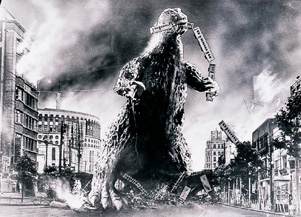|
|
Viking Night: Gojira/Godzilla: King of the MonstersBy Bruce HallMay 13, 2014
Godzilla's climactic rampage through Tokyo is the highlight of both films, and the effects - somewhat cut rate even then – still get the job done. Yes, it’s just a guy in a rubber suit, and in fact his first appearance on screen is rather unimpressive. It’s just an animatronic contraption that twitched and jerked like a. But I would argue that the more realistic movements of an actor as opposed to a stop motion miniature only add to the film’s intensity. For atmospheric reasons Gojira was intentionally shot in black and white, and the tiny model Tokyo is so well built, that while it’s obviously a miniature, there are occasional scenes where you forget about it entirely. The sound design on this movie is stellar, and as a whole the original film feels much more like a wartime drama than low budget monster movie. Still, the American film does an effective job of combining the new and old footage, and of taking itself just as seriously as the original. It’s actually possible to watch both versions back to back, enjoy them and come away with independent impressions. The best thing is that whether you’re watching Gojira or Godzilla, you’re bound to enjoy it more than you thought you would. For me, hearing Godzilla’s theme song - as plodding and arthritic as the big guy himself - as he stomps buildings, eats trains and swats planes out of the air was as satisfying today as it was when I was six. Classic movies tend to hold up narratively, if not tonally, and they make it easy for you to suspend disbelief and accept what you see. Gojira/Godzilla does both - so before you check out the reboot, check out the original – a solid example of how to make two good movies out of one, should the need ever arise.
|

|
|
|

|
Thursday, April 25, 2024
© 2024 Box Office Prophets, a division of One Of Us, Inc.


